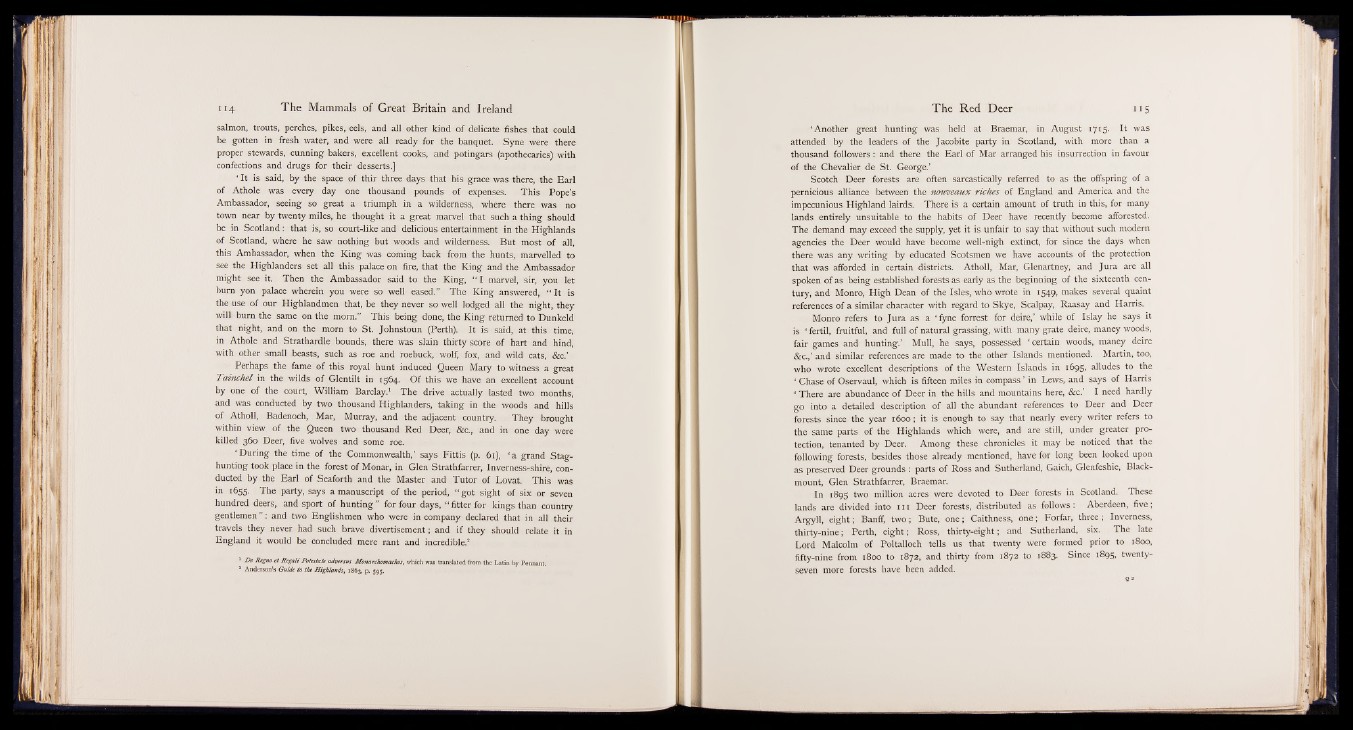
salmon, trouts, perches, pikes, eels, and all other kind of delicate fishes that could
be gotten in fresh water, and were all ready for the banquet. Syne were there
proper stewards, cunning bakers, excellent cooks, and potingars (apothecaries) with
confections and drugs for their desserts.]
‘ It is said, by the space of thir three days that his grace was there, the Earl
of Athole was every day one thousand pounds of expenses. This Pope’s
Ambassador, seeing so great a triumph in a wilderness, where there was no
town near by twenty miles, he thought it a great marvel that such a thing should
be in Scotland: that is, so court-like and delicious entertainment in the Highlands
of Scotland, where he saw nothing but woods and wilderness. But most of all,
this Ambassador, when the King was coming back from the hunts, marvelled to
see the Highlanders set all this palace on fire, that the King and the Ambassador
might see it. Then the Ambassador said to the King, “ I marvel, sir, you let
burn yon palace wherein you were so well eased.” The King answered, “ It is
the use of our Highlandmen that, be they never so well lodged all the night, they
will burn the same on the morn.” This being done, the King returned to Dunkeld
that night, and on the morn to St. Johnstoun (Perth). It is said, at this time,
in Athole and Strathardle bounds, there was slain thirty score of hart and hind,
with other small beasts, such as roe and roebuck, wolf, fox, and wild cats, &c.’
Perhaps the fame of this royal hunt induced Queen Mary to witness a great
Tainchel in the wilds of Glentilt in 1564. Of this we have an excellent account
by one of the court, William Barclay.1 The drive actually lasted two months,
and was conducted by two thousand Highlanders, taking in the woods and hills
of Atholl, Badenoch, Mar, Murray, and the adjacent country. They brought
within view of the Queen two thousand Red Deer, &c., and in one day were
killed 360 Deer, five wolves and some roe.
‘ During the time of the Commonwealth,’ says Fittis (p. 61), * a grand Staghunting
took place in the forest of Monar, in Glen Strathfarrer, Inverness-shire, conducted
by the Earl of Seaforth and the Master and Tutor of Lovat. This was
in 1655. The party, says a manuscript of the period, “ got sight of six or seven
hundred deers, and sport of hunting ” for four days, “ fitter for kings than country
gentlemen ” : and two Englishmen who were in company declared that in all their
travels they never had such brave divertisement; and if they should relate it in
England it would be concluded mere rant and incredible.2
1 De Regno et Regali Potentate adversus Monanhomachos, which was translated from the Latin by Pennant.
* Anderson’s Guide to the Highlands, 1863, p. 595.
‘ Another great hunting was held at Braemar, in August 1715. It was
attended by the leaders of the Jacobite party in Scotland, with more than a
thousand followers: and there the Earl of Mar arranged his insurrection in favour
of the Chevalier de St. George.’
Scotch Deer forests are often sarcastically referred to as the offspring of a
pernicious alliance between the nouveaux riches of England and America and the
impecunious Highland lairds. There is a certain amount of truth in this, for many
lands entirely unsuitable to the habits of Deer have recently become afforested.
The demand may exceed the supply, yet it is unfair to say that without such modern
agencies the Deer would have become well-nigh extinct, for since the days when
there was any writing by educated Scotsmen we have accounts of the protection
that was afforded in certain districts. Atholl, Mar, Glenartney, and Jura are all
spoken of as being established forests as early as the beginning of the sixteenth century,
and Monro, High Dean of the Isles, who wrote in 1549» niakes several quaint
references of a similar character with regard to Skye, Scalpay, Raasay and Harris.
Monro refers to Jura as a ‘ fyne forrest for deire,’ while of Islay he says it
is ‘ fertil, fruitful, and full of natural grassing, with many grate deire, maney woods,
fair games and hunting.’ Mull, he says, possessed ‘ certain woods, maney deire
&c.,’ and similar references are made to the other Islands mentioned. Martin, too,
who wrote excellent descriptions of the Western Islands in 1695, alludes to the
‘ Chase of Oservaul, which is fifteen miles in compass ’ in Lews, and says of Harris
* There are abundance of Deer in the hills and mountains here, &c. I need hardly
go into a detailed description of all the abundant references to Deer and Deer
forests since the year 1600; it is enough to say that nearly every writer refers to
the same parts of the Highlands which were, and are still, under greater protection,
tenanted by Deer. Among these chronicles it may be noticed that the
following forests, besides those already mentioned, have for long been looked upon
as preserved Deer grounds : parts of Ross and Sutherland, Gaich, Glenfeshie, Black-
mount, Glen Strathfarrer, Braemar.
In 1895 two million acres were devoted to Deer forests in Scotland. These
lands are divided into 111 Deer forests, distributed as follows: Aberdeen, five;
Argyll, eight; Banff, tw o; Bute, one; Caithness, one; Forfar, three; Inverness,
thirty-nine; Perth, eight; Ross, thirty-eight; and Sutherland, six. The late
Lord Malcolm of Poltalloch tells us that twenty were formed prior to 1800,
fifty-nine from 1800 to 1872, and thirty from 1872 to 1883. Since 1895, twenty-
seven more forests have been added.